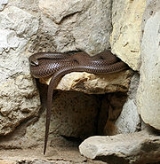
Rhamphiophis oxyrhynchus
Encyclopedia
The Rufous Beaked Snake (Rhamphiophis oxyrhynchus) is a species of colubrid
from West Africa. It is named for its hooked snout, which it uses to dig burrows, and reddish-brown back scales. It hunts small animals during the day with the help of its venomous bite. There are two subspecies, R.o. oxyrhynchus (Reinhardt 1843) and R.o. rostratus (Peters 1854).
. While its back tends to be yellowish-brown to reddish-brown, its belly is cream or yellowish-white.
, north Zimbabwe
, Mozambique
, and Sudan
. It primarily inhabits bushveld
and thornveld habitats.
called rufoxin, causes hypotension
and circulatory shock in small mammals, but is not dangerous to humans.
Colubrid
A colubrid is a member of the snake family Colubridae. This broad classification of snakes includes about two-thirds of all snake species on earth. The earliest species of the snake family date back to the Oligocene epoch. With 304 genera and 1,938 species, Colubridae is the largest snake family...
from West Africa. It is named for its hooked snout, which it uses to dig burrows, and reddish-brown back scales. It hunts small animals during the day with the help of its venomous bite. There are two subspecies, R.o. oxyrhynchus (Reinhardt 1843) and R.o. rostratus (Peters 1854).
Description
The Rufous Beaked Snake is large and stout, with males reaching a maximum length of 1.1 m (3.6 ft) and females reaching 1.07 m (3.5 ft). It has a shortened skull, as with all beaked snakes, giving it a clear distinction between its head and body, as well as a dark brown eyestripe running down the side of its head. Its eyes are large with round pupilPupil
The pupil is a hole located in the center of the iris of the eye that allows light to enter the retina. It appears black because most of the light entering the pupil is absorbed by the tissues inside the eye. In humans the pupil is round, but other species, such as some cats, have slit pupils. In...
. While its back tends to be yellowish-brown to reddish-brown, its belly is cream or yellowish-white.
Habitat
The Rufous Beaked Snake's range includes north BotswanaBotswana
Botswana, officially the Republic of Botswana , is a landlocked country located in Southern Africa. The citizens are referred to as "Batswana" . Formerly the British protectorate of Bechuanaland, Botswana adopted its new name after becoming independent within the Commonwealth on 30 September 1966...
, north Zimbabwe
Zimbabwe
Zimbabwe is a landlocked country located in the southern part of the African continent, between the Zambezi and Limpopo rivers. It is bordered by South Africa to the south, Botswana to the southwest, Zambia and a tip of Namibia to the northwest and Mozambique to the east. Zimbabwe has three...
, Mozambique
Mozambique
Mozambique, officially the Republic of Mozambique , is a country in southeastern Africa bordered by the Indian Ocean to the east, Tanzania to the north, Malawi and Zambia to the northwest, Zimbabwe to the west and Swaziland and South Africa to the southwest...
, and Sudan
Sudan
Sudan , officially the Republic of the Sudan , is a country in North Africa, sometimes considered part of the Middle East politically. It is bordered by Egypt to the north, the Red Sea to the northeast, Eritrea and Ethiopia to the east, South Sudan to the south, the Central African Republic to the...
. It primarily inhabits bushveld
Bushveld
The Bushveld is a sub-tropical woodland ecoregion of Southern Africa that encompasses most of Limpopo Province and a small part of the North West Province of South Africa, the Central and North-East Districts of Botswana and the Matabeleland South and part of th Matabeleland North provinces of...
and thornveld habitats.
Biology
Diurnal animals, Rufous Beaked Snakes hunt small animals, including other snakes, but stay in burrows during the hottest part of the day. In the summer, females lay 8-17 cylindrical eggs with dimensions of about 36 by 21 mm (1.4 by 0.826771653543307 in) over the span of several days. The snake's venom, one of its components of which is a neurotoxinNeurotoxin
A neurotoxin is a toxin that acts specifically on nerve cells , usually by interacting with membrane proteins such as ion channels. Some sources are more general, and define the effect of neurotoxins as occurring at nerve tissue...
called rufoxin, causes hypotension
Hypotension
In physiology and medicine, hypotension is abnormally low blood pressure, especially in the arteries of the systemic circulation. It is best understood as a physiologic state, rather than a disease. It is often associated with shock, though not necessarily indicative of it. Hypotension is the...
and circulatory shock in small mammals, but is not dangerous to humans.

